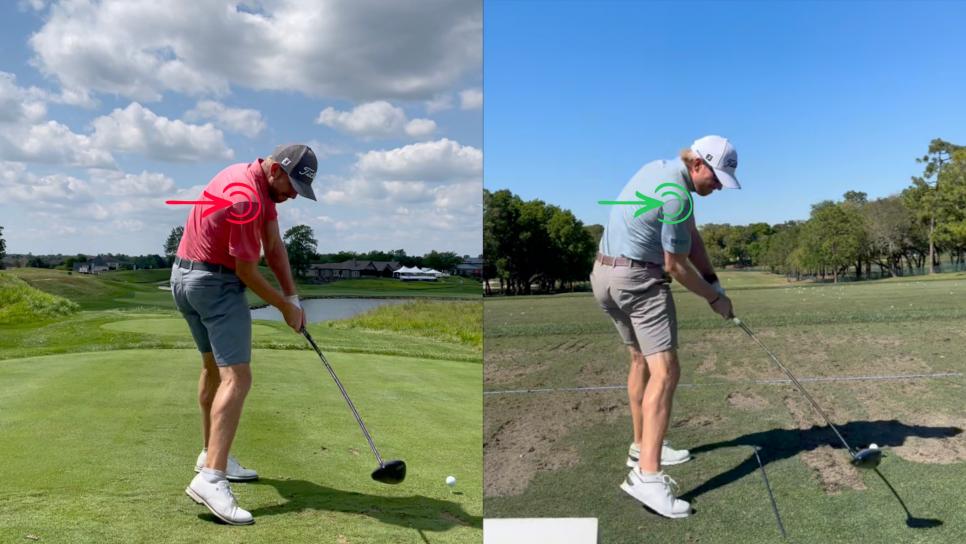Jimmy Stanger is one of the best driver’s on the PGA Tour. But it wasn’t always that way.
It’s pretty common for tour players to undergo something of a transformation. Junior golfers grow up slinging big draws – it’s their way of learning to hit the ball further before the muscles in their upper body have fully developed. This was true even for the likes of Tiger Woods, who joked that as a junior golfer his fades were actually just “smaller draws”.
Then, often about the late teens for most players, they begin to fill out their upper body and their golf swing begins to change. They become less dependent on timing with their hands, find a ball flight that’s more controlled, predictable and dependable.
Stanger is a PGA Tour rookie who ranked fifth in total driving last season on the Korn Ferry Tour and is 18th in Strokes Gained/Off-The-Tee so far this season. He’s an elite driver of the ball by any standard, and he too went through a similar transformation – albeit a few years later than others.
“It was funny. The first couple of years I was a professional golfer, I definitely was not an elite driver of the golf ball,” he says. “It was a little sideways; I wasn’t the longest; it was just overall inconsistent. I didn’t quite know if it would draw or fade; it was more of a shotgun approach about getting it in play, and using my putter to play well.”
Sensing an opportunity to improve, Stanger and his coach, Golf Digest Best in State Teacher John Scott Rattan, the former coach at the University of Virginia who recruited Stanger to play there, got some dialling-in his draw for more consistency.
1. Arms more around, less up-and-under
Stanger is an ultra-talented athlete who always had a “beautiful golf swing”, Rattan says. One of the key changes that upgraded the consistency of Stanger’s powerful draw move was learning to turn his arms more around his body.
“He didn’t have a lot of depth in his backswing. He would pick his arms slightly out and up, on the backswing, then drop them under,” Rattan says.
Instead, Rattan says he and Stanger worked on getting his hands moving deeper and more around his body on the backswing, which propelled them back in front of him on the downswing (as you can see here on the right).

When Stanger’s arms tracked too vertically up on the backswing, they would then drop down too vertically behind his body on the downswing (as you can see on the left).
“It’s a common move for players who like to draw it, but it relies a lot on your wrists,” Rattan says. “Sometimes it’ll draw; sometimes it’ll hook, sometimes it’ll push.”
2. Turn your chest aggressively to ‘fly the kite’
With his arms tracking deeper on the backswing, Stanger now had the freedom to turn his chest aggressively through the ball. Stanger says he feels like he grips the ground with his feet, and turns aggressively through. It’s a move that makes the golf swing feel easy – a feeling he quickly learned to love.
“I’ve learned that it’s more of a slingshot feeling,” Stanger says. “All of a sudden, now I feel like I’m swinging and the club’s just a kite that’s following me. I’m just turning the body and the club falls.”

Rattan adds: “He’ll often talk of his chest turning his torso into his lead arm. His lead arm is the string, and the club is the kite,” he says. “With his club and arms in a good position coming down, it gives him the freedom to rotate.”
3. Learning to love knockdown shots
The combination of getting his arms deeper on the backswing, turning his torso into his lead arm on the downswing helps Stanger’s arms and club move less out to the right, and more around him through the ball.
“It’s something I’m still working to perfect, but hitting knockdown shots helps,” Stanger says.

Knockdown shots have become part of his practice routine, which as Rattan explains, helps improve some technical areas of his swing, without taking away what feels natural.
“He has a big, free-flowing finish,” Rattan says. “I love that. That’s what the best drivers in the game have had. He’s worked hard on some things in his golf swing, but that finish won’t ever change.



